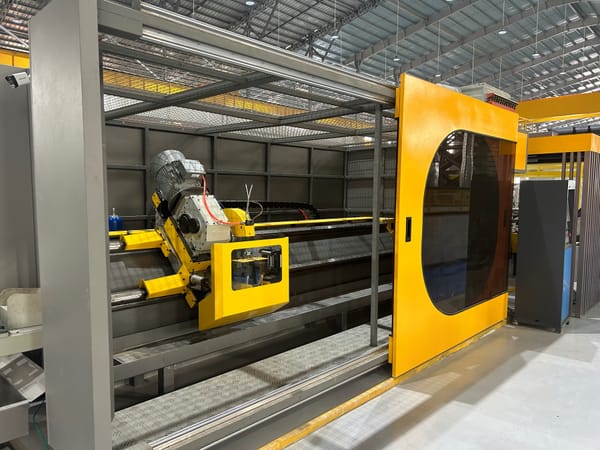
After the ERW pipe or tube has been formed, welded, and sized to its final dimensions, it needs to be cut into specific lengths. This is performed by cut-off equipment, primarily Flying Saws, which are designed to cut the continuously moving tube without stopping the production line. There are two main types: Flying Cold Saws and Hot Saws, each with distinct characteristics and applications.
Flying Saw Cut-Off Equipment
A flying saw is an automated device that moves along with the continuously advancing pipe or tube, cuts it to a predetermined length, and then returns to its starting position to await the next cut. This synchronization with the mill speed is crucial for maintaining continuous production.
Hot Saw
Functionality: A hot saw, also known as a friction saw, uses a high-speed rotating blade that generates significant heat upon contact with the pipe. This heat, combined with the friction, melts and cuts through the metal. The cutting process often produces sparks and can leave a rough, discolored (often purple) cut surface.
Characteristics
High Efficiency Hot saws are generally very efficient and can cut through a wide range of pipe thicknesses and diameters quickly.
Suitable for All Thicknesses They are particularly well-suited for cutting thicker-walled pipes where cold cutting would be slower or require more powerful machinery.
Rough Cut The cut end face is typically rough, with burrs and a heat-affected zone. This often necessitates secondary finishing operations like deburring or chamfering.
Noise and Sparks Hot saws are known for generating considerable noise and sparks during operation.
Flying Cold Saw
Functionality A flying cold saw uses a specialized saw blade, often made of tungsten carbide, that cuts the pipe at ambient or near-ambient temperatures. The blade and workpiece are kept cool, often with a coolant system, to prevent heat buildup.
Characteristics
High Precision and Clean Cut: Cold saws provide a much cleaner, smoother cut with high cross-section precision and minimal to no burrs, both inside and outside the pipe. This often eliminates or significantly reduces the need for subsequent finishing processes.
No Heat-Affected Zone Since the cutting is done cold, there is no heat-affected zone, preserving the metallurgical properties of the pipe material near the cut.
Less Noise and Sparks Compared to hot saws, cold saws operate with significantly less noise and produce no sparks.
Speed Limitations While modern cold saws are very fast (some reaching cutting speeds of up to 300 feet per minute), they might have limitations on the maximum thickness or diameter they can efficiently cut compared to hot saws.
Blade Life The specialized blades can be expensive and require careful maintenance.
Difference Between Them
| Feature | Hot Saw (Friction Saw) | Flying Cold Saw |
|---|---|---|
| Cutting Mechanism | High-speed friction and heat generation | Mechanical cutting with a cooled blade |
| Cut Quality | Rough, burrs, heat-affected zone, discolored | Clean, smooth, high precision, minimal burrs, no heat effect |
| Speed | Very fast, especially for thicker materials | Fast, but can have limitations on very thick materials |
| Noise/Sparks | High noise, significant sparks | Low noise, no sparks |
| Post-Processing | Often requires deburning/finishing | Often eliminates or reduces post-processing |
| Application | Versatile for various thicknesses, where cut quality is less critical | Preferred for high-quality cuts, thinner to medium-thick materials |
Choosing between a hot saw and a flying cold saw depends on the specific requirements of the ERW tube mill, including the material being cut, desired cut quality, production speed, and subsequent processing steps. Many modern mills opt for flying cold saws due to the superior cut quality and reduced need for secondary operations.
